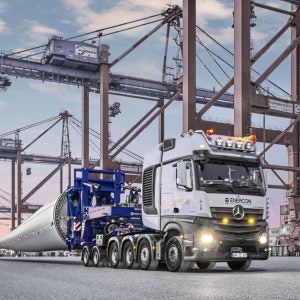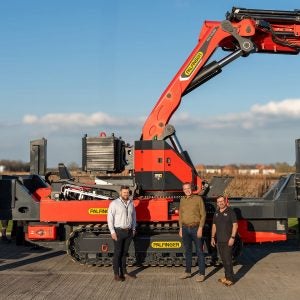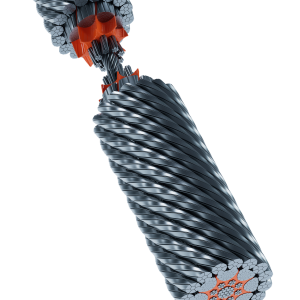Link-Belt will unveil next month the RTC-80100 Series II rough terrain crane at the Conexpo-Con/Agg show in Las Vegas. It is rated at 100 US ton (90t) capacity, and the first thing anyone checking out the crane will notice is that it has three axles.
Key features of the RTC-80100 are its 6 x 6 x 6 hydrostatic drive, 23.5R25 size wheels, and a new ‘formed’ boom design. This new design delivers full power boom and telescoping load capability and a maximum tip height of 243ft (69.5m) with attachments.
Unlike any other RT in this class, Link Belt says, this crane strips down to less than 90,000lb (41t) in under an hour without an assist crane. The tyres do not need to be removed for transport. Only the counterweight and outrigger boxes need to be removed to get the crane’s vehicle width to 10ft (3.05m). Because it is under 10ft wide and (because of smaller tyres) features a low 12ft 2.5in (3.72 m) overall height, US customers should find that the RTC-80100 incurs no daytime or weekend travel restrictions. Until now, RTs of this capacity have exceeded width and weight restrictions, and so required special permits.
The crane ships in two loads, with the main unit on a conventional drop-deck trailer and counterweight, fly extensions and outrigger boxes following on a second truck.
Link-Belt stresses that it doesn’t just move easily between sites, but also shows good manoeuvrability on site, thanks to its hydrostatic drive on each wheel. This aids creep control and allows a tight turning circle, allowing the crane to turn 180° within its own length. Additionally, the operator has a choice of four steering modes: front only, coordinated six wheel, six wheel ‘crab’, and rear only.
Link-Belt’s familiar Boss boom, with the diamond holes, has been replaced by a more modern U-shaped boom which represents the next generation in Link-Belt’s telescopic booms on its larger cranes. Strategically placed wear pads are used throughout the boom to disperse the load to maximise its overall strength and stability, particularly when lifting at longer radii.
The five-section, full-power, 150ft (45.72m) main boom has a quick reeve boom head. Main boom maximum tip height is 159ft 6in (48.62m). With the optional 31ft to 55ft (9.44m-16.76m) two-piece (bi-fold) fly, the maximum tip height is 214ft (65.23 m) and the fly is stowable and offsettable to 2°, 25° and 45°. When not in use there is no deduction necessary for the jib when stowed. Optional 15ft (4.57m) fly extensions can be added to extend the bi-fold attachment to 70ft with one section and 85ft using two sections. Maximum tip height with the bi-fold attachment and one extension is 228ft 6in (69.64m). With two extensions the maximum tip height is 243ft (74.07m).
The RTC-80100 offers three boom modes: Standard, A-max1 and A-max2. In the A-max1 mode, the boom is 95ft (29m) long. Inner and centre sections are extended, offering maximum strength. In the A-max2 mode, the boom length is 122ft 6in (37.34m). Tip, outer and centre sections are extended, yielding maximum stability. Link-Belt claims that its full power boom can telescope heavier loads than the power-pinned booms of certain competitors, and it believes that its new boom will appeal to rental houses because of the simplicity of operation.
The RTC-80100 is powered by a 300hp (224kW) Detroit Diesel Series 40, six-cylinder engine with 1,050lb/ft. (1,424Nm) of torque. Both the front and rear suspension are fully independent with lockouts.
‘We are very excited about the prospects of the RTC-80100 in applications where big capacity, reach, manoeuvrability, low overall height and ease of transport are all key,’ said Link-Belt’s sales and marketing director Bill Stramer. ‘We think the RTC-80100 is right on the mark with its innovative features.’
The RTC-80100 is featured on the cover of the February issue of Cranes Today.






